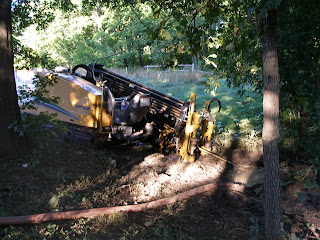Off the Grid in the Strib.
http://www.startribune.com/lifestyle/homegarden/128690998.html#
This is Gary Johnson in my garden design at Valley Natural Foods.
Star and Tribune Article
Most community gardens are a checkerboard of squares or rectangles. But the plots at Valley Natural Foods Co-op in Burnsville break the mold. Instead, they're laid out as an undulating series of keyhole-shaped beds, set within two large circles.
"They face each other, to foster conversation," said Gary Johnson, community relations developer for the co-op.
Apparently that mission is being accomplished. "I love them," gardener Debi Welch said of the garden's three dozen rounded beds. "You know how many friends I've made since I've been over there? People talk and ask questions, they honk when they drive by. It's a social network."
The distinctive keyhole-shaped design is called a mandala garden, and it's an old-school style of gardening that is making a comeback, fueled by the sustainability movement.
Horticulturist Dan Halsey of Southwoods Forest Gardens in Prior Lake has designed several mandala gardens, including the two at the co-op, during the past couple of growing seasons, and taught a class on the subject there this spring.
While mandala gardens may look new to those of us accustomed to linear beds, they're anything but, said Halsey, who saw examples at George Washington's farm in Virginia. "We're just rediscovering all this great stuff."
What makes them so great? In addition to the conversational benefits, mandala gardens are good for food production and easy on gardeners and natural resources, Halsey said.
He became fascinated with mandala gardening while studying permaculture, a philosophy of designing sustainable agricultural systems modeled on nature.
"There's nothing square in nature," Halsey noted. "Grids and squares are inefficient." They accommodate machinery and big agriculture but aren't ideal for community gardens because so much of the land gets taken up by walkways, which causes water to collect there rather than on the crops.
"By the time you're done, half the soil is in the paths," Halsey said. "With this, there's one little path."
'Human-centric'
Mandala gardens are also gardener-friendly because the design is "human-centric," Halsey said. Gardeners kneel in the center of the bed and plant in a 3-foot radius (about an arm's length) around them.
And instead of planting crops in straight, generously spaced rows, Halsey advocates crowding the beds with a mixed assortment of plants -- "like flower arranging," he said. He doesn't plant corn next to corn, and cauliflower next to cauliflower. "That attracts insects; it's like an Old Country Buffet for them."
Intensely planted beds also minimize weeding, and the plants thrive just fine, Halsey said. "In Minnesota, we have gold for soil. If we didn't have winter, we'd have a rain forest. We can plant a lot closer."
That approach works for Welch, who grows more than two dozen crops on her keyhole bed, with help from her six grandkids. "That's how I was raised," she said. "If there's an empty spot, put a plant in it."
The mandala community gardens are part of Valley Natural Foods Co-op's new vision for its suburban site, according to Johnson. For years, the co-op was surrounded by a big manicured lawn. But its shareholder members decided two years ago to convert its land into a permaculture laboratory.
Last year it installed a vegetable teaching garden and donated the produce, about 400 pounds, to local nonprofits. This year, the co-op added the mandala community gardens, not to beautify the site but to maximize its productivity.
"It's not about aesthetics; it's about functionality," Halsey said. "The aesthetics -- I think they're great, but they're not going to win awards from Bachman's."
There's no hardscape, and no hose or sprinkler system. The beds are all hand-watered, at Halsey's insistence. "When you have to carry it in cans, you're more frugal," he said. "Most community gardens are over-watered."
And there's a side benefit, Johnson said. "Carrying a bucket exercises muscles."
Water-carrying aside, the mandala community garden is user-friendly. The co-op cut the sod and supplies all compost, fencing, water and watering can for a fee of $24 per gardener for the growing season.
"There are gardeners here who have never gardened before," Johnson said. "We made it easy for them. Like furnished apartments."
Welch, for one, is hooked. "Oh, yeah, I'm coming back next year," she said. "I enjoy the heck out of it. I'm going to miss it when the snow falls."
Kim Palmer • 612-673-4784
This is Gary Johnson in my garden design at Valley Natural Foods.
Star and Tribune Article
Most community gardens are a checkerboard of squares or rectangles. But the plots at Valley Natural Foods Co-op in Burnsville break the mold. Instead, they're laid out as an undulating series of keyhole-shaped beds, set within two large circles.
"They face each other, to foster conversation," said Gary Johnson, community relations developer for the co-op.
Apparently that mission is being accomplished. "I love them," gardener Debi Welch said of the garden's three dozen rounded beds. "You know how many friends I've made since I've been over there? People talk and ask questions, they honk when they drive by. It's a social network."
The distinctive keyhole-shaped design is called a mandala garden, and it's an old-school style of gardening that is making a comeback, fueled by the sustainability movement.
Horticulturist Dan Halsey of Southwoods Forest Gardens in Prior Lake has designed several mandala gardens, including the two at the co-op, during the past couple of growing seasons, and taught a class on the subject there this spring.
While mandala gardens may look new to those of us accustomed to linear beds, they're anything but, said Halsey, who saw examples at George Washington's farm in Virginia. "We're just rediscovering all this great stuff."
What makes them so great? In addition to the conversational benefits, mandala gardens are good for food production and easy on gardeners and natural resources, Halsey said.
He became fascinated with mandala gardening while studying permaculture, a philosophy of designing sustainable agricultural systems modeled on nature.
"There's nothing square in nature," Halsey noted. "Grids and squares are inefficient." They accommodate machinery and big agriculture but aren't ideal for community gardens because so much of the land gets taken up by walkways, which causes water to collect there rather than on the crops.
"By the time you're done, half the soil is in the paths," Halsey said. "With this, there's one little path."
'Human-centric'
Mandala gardens are also gardener-friendly because the design is "human-centric," Halsey said. Gardeners kneel in the center of the bed and plant in a 3-foot radius (about an arm's length) around them.
And instead of planting crops in straight, generously spaced rows, Halsey advocates crowding the beds with a mixed assortment of plants -- "like flower arranging," he said. He doesn't plant corn next to corn, and cauliflower next to cauliflower. "That attracts insects; it's like an Old Country Buffet for them."
Intensely planted beds also minimize weeding, and the plants thrive just fine, Halsey said. "In Minnesota, we have gold for soil. If we didn't have winter, we'd have a rain forest. We can plant a lot closer."
That approach works for Welch, who grows more than two dozen crops on her keyhole bed, with help from her six grandkids. "That's how I was raised," she said. "If there's an empty spot, put a plant in it."
The mandala community gardens are part of Valley Natural Foods Co-op's new vision for its suburban site, according to Johnson. For years, the co-op was surrounded by a big manicured lawn. But its shareholder members decided two years ago to convert its land into a permaculture laboratory.
Last year it installed a vegetable teaching garden and donated the produce, about 400 pounds, to local nonprofits. This year, the co-op added the mandala community gardens, not to beautify the site but to maximize its productivity.
"It's not about aesthetics; it's about functionality," Halsey said. "The aesthetics -- I think they're great, but they're not going to win awards from Bachman's."
There's no hardscape, and no hose or sprinkler system. The beds are all hand-watered, at Halsey's insistence. "When you have to carry it in cans, you're more frugal," he said. "Most community gardens are over-watered."
And there's a side benefit, Johnson said. "Carrying a bucket exercises muscles."
Water-carrying aside, the mandala community garden is user-friendly. The co-op cut the sod and supplies all compost, fencing, water and watering can for a fee of $24 per gardener for the growing season.
"There are gardeners here who have never gardened before," Johnson said. "We made it easy for them. Like furnished apartments."
Welch, for one, is hooked. "Oh, yeah, I'm coming back next year," she said. "I enjoy the heck out of it. I'm going to miss it when the snow falls."
Kim Palmer • 612-673-4784


Comments